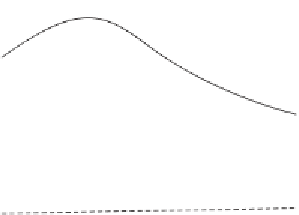Geoscience Reference
In-Depth Information
P
earth's
surface
P
0
geoid
±
N
N
c
P
c
cogeoid
N
ellipsoid
Q
0
Fig. 8.1. Geoid and cogeoid
formulas.
This is the purpose of the various gravity reductions
.Theywere
considered extensively in Chap. 3; we therefore can limit ourselves to pointing
out those theoretical features that are relevant to our present problem.
If the external masses, the masses outside the geoid, are removed or
moved inside the geoid, then gravity changes. Furthermore, gravity is ob-
served at ground level but is needed at sea level. Thus, the reduction of
gravity involves the consideration of these two effects, in order to obtain
boundary values on the geoid.
This
regularization
of the geoid by removing the external masses unfortu-
nately also changes the level surfaces and hence, in general, the geoid. This is
the
indirect effect
; the changed geoid is called the
cogeoid
or the regularized
geoid.
The principle of this method may be described as follows (Jung 1956:
p. 578); see Fig. 8.1.
1. The masses outside the geoid are, by computation, either removed
entirely or else moved inside the geoid. The effect of this procedure on
the value of gravity
g
at the station
P
is considered.
2. The gravity station is moved from
P
down to the geoid, to the point
P
0
. Again, the corresponding effect on the gravity is considered.
3. The indirect effect, the distance
δN
=
P
0
P
c
, is obtained by dividing
the change in potential at the geoid,
δW
, by normal gravity (Bruns'
theorem):
δN
=
δW
γ
.
(8-3)
4. The gravity station is now moved from the geoidal point
P
0
to the







